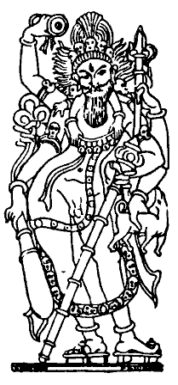


Shiva to Shankara: Decoding the Phallic Symbol
By Dr Devdutt PattanaikISBN 81-88569-04-6
Price: Rs 225, paperback, 167 pages
Web site Indus Source
I like this book a lot. It explores the emergence of Shiva through Veda, Purana, Tantra and other places and illustrates some deep philosophy with reference to stories and legends in texts, through folklore and with some interesting diagrams.
While Shiva is the ice-cool ascetic extraordinaire, that ain't necessarily so always and at all times. A whole body of material illustrates the Shiva phenomenon in the light of Shakti in her various guises, whether as Sati, Gauri, Kali or Annapurna.
Daksha didn't like his yajna disturbed by Mahadeva with his retinue of misshapen mates, the ganas, but in the end the old Vedic ways of worship were supplanted in favour of ascetism or alchemy, or perhaps sometimes a combination of both. While many Shiva devotees in India itself will seek to downplay the phallic significance of the lingam, Dr Pattanaik shows by reference to many different short texts that Mahadeva's real nature is ambiguous in the extreme but fundamentally posited on the lingam as a transcendent symbol, played out on the canvas of the reality of female and male relationships.
The book contrasts the Vaishnav approach with the Shaivite. Dr Pattanaik illustrates the differences between Vishnu and Shiva in this table below.
| Shiva (Hara) | Vishnu (Hari) | |
| Abode | Snow-capped mountain | Ocean of milk |
| Clothes | Animal skins | Silk robes |
| Cosmetic | Ash | Sandal Paste |
| Jewellery | Snakes and Beads | Flowers and Gold |
| Association with the creative aspect of God, Brahma | Carries Brahma's skull as his begging bowl | The lotus that rises from his navel gives birth to Brahma |
| Offering | Raw milk | Butter |
At one time each cult sought to portray each devata as the supreme symbol of the Brahman - according to early European accounts this led to bitter squabbles and even violence between the adherents. The denial of Shiva's lingam being an emblem of the phallus even led to the column being sheathed by male faces in some temples.
"Shiva's association with low-caste people and his disregard for formal ritual made him popular among the masses... Shiva's entourage of ganas as described as an unruly and rowdy bunch of wild ogres who obtain true unconditional acceptance from Shiva. He drinks with them, smokes with them and never gets annoyed with their rather antisocial behaviour." - page 114.
There's a nice quote from the Navnath Charitra which has Shiva and Parvati talking about the existence of the world in a cave, deep in the Himalaya. He explains to her, tantra fashion, how secret the knowledge is. But, unknown to both, a small fish inside a pond in the cave heard the conversation and was able to make himself into a man with the knowledge. "He travelled the earth, sharing with everyone what he had heard Shiva tell Parvati. He was known as Matsyendranath. He had eight disciples who went to the eight corners of the world, carrying the word of Shiva."
Despite Shiva's role as an ascetic, an emergency rose in the heavenly spheres and he had to father children, ending up with an unusual family consisting of his wife Gauri, the elephant-headed god Ganesh, and Skanda. The child he fathered through his relationship with Vishnu in his female guise as Mohini produced a child, Ayappa, still worshipped in South India and somewhat reconciling the sectarian divisions between Vaishnav and Shakta cults.
The book is illustrated throughout, and includes some unusual and rare photographs, including one of the famous ice linga, strewn with bel leaves. Dr Pattanaik uses the texts and the folklore to make some subtle and deep insights into the legends and the stories. When Shiva as the ice cold ascetic was woken to the reality of Shakti, he becomes Shankara and the interplay of both represents harmony between the "inside" and the "outside", which are both and neither. This is a fine book, thoroughly recommended. MM
Artwork is © Jan Bailey, 1996-2018. Translations are © Mike Magee 1996-2018. Questions or comments to mike.magee@btinternet.com
Home Page